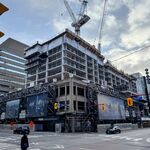TossYourJacket
Senior Member
But it's also where a lot of the destinations are. They are both major shopping streets. People are biking to places along those streets. Which is why the side streets thing is stupid. People aren't going to places on the side streets. People still need to get to the destinations on the main streets, so now instead of letting them get there safely, the province has decided that it's okay if they die on that last little part of the journey.These are also 2 of the longest in the city? This is not a per capita or per km number. Yes, I expect these long corridors would account for most rides.
I think the problem is our highway-obsessed government thinks of bike lanes only as highways for bikes, and not as a thing people can use to access local businesses along those bike routes.





